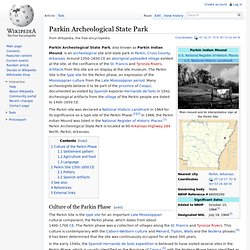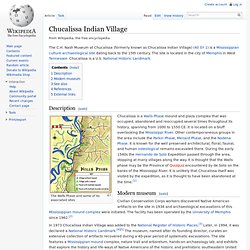

Parkin Archeological State Park. The Parkin site was declared a National Historic Landmark in 1964 for its significance as a type site of the Parkin Phase.[2][3] In 1966, the Parkin Indian Mound was listed in the National Register of Historic Places.[1] Parkin Archeological State Park is located at 60 Arkansas Highway 184 North, Parkin, Arkansas.

Culture of the Parkin Phase[edit] The Parkin Site is the type site for an important Late Mississippian cultural component, the Parkin phase, which dates from about 1400–1700 CE. The Parkin phase was a collection of villages along the St. Francis and Tyronza Rivers. This culture is contemporary with the Caborn-Welborn culture and Menard, Tipton, Walls and the Nodena phases.[4] It has been determined that the site was continuously occupied for at least 500 years. Settlement pattern[edit] Holly Bluff Site. It was declared a National Historic Landmark in 1964.[2] Location[edit] One of the half dozen really big sites in the State of Mississippi, the Holly Bluff Site is located on the south bank of George Lake, or Lake George as it is sometimes known, a half mile east of its confluence with the Sunflower River and a mile and a half southeast of the village of Holly Bluff, Yazoo County.

Chucalissa Indian Village. The C.H.

Nash Museum at Chucalissa (formerly known as Chucalissa Indian Village) (40 SY 1) is a Mississippian culture archaeological site dating back to the 15th century. The site is located in the city of Memphis in West Tennessee. Chucalissa is a U.S. National Historic Landmark. Description[edit] The Walls Phase and some of its associated sites Modern museum[edit] In 1973 Chucalissa Indian Village was added to the National Register of Historic Places.[3] Later, in 1994, it was declared a National Historic Landmark.[4][5] The museum, named after its founding director, curates an extensive collection of artifacts recovered during a 40-year period of systematic excavations. Woodland period. Angel Mounds. History[edit] For thousands of years, southwestern Indiana was home to successive cultures of Native Americans, who settled near the rivers and used them for travel and trade.

Beginning after 1000 CE, people of the widespread Mississippian culture built a town at this site, covering 100 acres (0.40 km2) and situated on a large, terraced mound near the river. Today, Angel Mounds State Historic Site is nationally recognized as one of the best-preserved prehistoric Native American sites in the United States. It was given National Historic Landmark status as part of this recognition. Cahokia the Ancient Walled City of North America. At its zenith, between A.D. 1050 and 1300 Cahokia grew dramatically with a population of more than 40,000 people in and around its main urban center.

Archaeological excavations have uncovered many remarkable artifacts that have given us an entirely new perspective as to what life in the Americas was like centuries before the European contact. The City Wall: The stockade wall enveloping Cahokia was nearly two miles long. It required roughly 20,000 one foot diameter logs each 20 feet tall. The wall was initially built sometime around A.D. 1100 and was subsequently rebuilt three more times over a 200 year period. There has been some debate among archeologists as to the purpose of the wall. Views of Cahokia as it is today. Cahokia. Cahokia was the largest and most influential urban settlement in the Mississippian culture which developed advanced societies across much of what is now the Southeastern United States, beginning more than 500 years before European contact.[5] Cahokia's population at its peak in the 1200s was among the largest cities in the world, and its ancient population would not be surpassed by any city in the United States until the late 18th century.

Today, Cahokia Mounds is considered the largest and most complex archaeological site north of the great Pre-Columbian cities in Mexico. Cahokia Mounds is a National Historic Landmark and designated site for state protection. In addition, it is one of only 21 UNESCO World Heritage Sites within the United States. Woodland period. Plaquemine culture. A map showing the geographical extent of the Plaquemine cultural period and some of its major sites.

The Plaquemine culture was an archaeological culture in the lower Mississippi River Valley in western Mississippi and eastern Louisiana. Good examples of this culture are the Medora Site ( the type site for the culture and period) in West Baton Rouge Parish, Louisiana, and the Anna, Emerald Mound, Winterville and Holly Bluff sites located in Mississippi.[1] Plaquemine culture was contemporaneous with the Middle Mississippian culture in the Cahokia site in St. Louis, Missouri. It is considered ancestral to the Natchez and Taensa Peoples.[2] Description[edit]